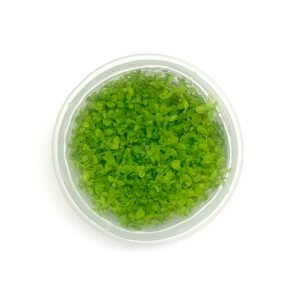Myriophyllum tuberculatum [Tc]
Myriophyllum tuberculatum [Tc]
₹275 Original price was: ₹275.₹250Current price is: ₹250./-
As any other red stem plant, this species is highly recommendable for setting colourful accents. A healthy group of M. tuberculatum is a real eyecatcher, a stunning fireball that draws all eyes. The plant is a great accompaniment for green Myriophyllum and Limnophila species. Its finely-structured leaves and its moderate size also makes it suitable for smaller planted tanks.
Out of stock
Out of stock
Details
yriophyllum tuberculatum populates slow-flowing and stagnant waters in the Asian tropics. M. tuberculatum is rather difficult in cultivation. It needs intensive light with at least 0.8 watts per litre, and CO2 injection is indispensable. Nitrates and phosphates should be maintained on a good level (5 to 15 and 1 to 2 mg/l, respectively). None of these main nutrients should ever fall to zero, otherwise the plant growth will be stunted. M. tuberculatum needs more iron and trace nutrients than most other stem plants. Without sufficient micronutrients the stems of this species remain very dark and small, and if there is an extreme deficit, the formative tissue of the shoot tip dies off. Under favourable conditions, the leaf whorls of M. tuberculatum can grow to a maximum diameter of around 10 cm and attain a rusty red colour.
Under good conditions this milfoil grows quickly to the water surface, where it grows lots of lateral shoots and develops a bushy habit. This species is best trimmed by removing the old stem and re-planting the strong upper part, as the rooted lower part only sprouts new shoots relatively slowly. For propagation, just cut off a lateral shoot and re-plant into the substrate.
Related products
Related products
-
29%
OFF
![Hygrophilla pinnatifida [Tc]](https://greenwateraquascapes.com/wp-content/uploads/2021/04/Tishu_products_11-300x300.jpg)
Hygrophilla pinnatifida [Tc]
₹350Original price was: ₹350.₹250Current price is: ₹250./- Read moreOut of stock
-
23%
OFF
![Micranthemum Callitrichoides 'Cuba' [Tc]](https://greenwateraquascapes.com/wp-content/uploads/2021/02/Tishu_product_07-1-300x300.jpg)
Micranthemum Callitrichoides ‘Cuba’ [Tc]
₹325Original price was: ₹325.₹250Current price is: ₹250./- Read moreOut of stock
-
23%
OFF
![Rotala rotundifolia 'Hi Red' (‘H’ra’) [Tc]](https://greenwateraquascapes.com/wp-content/uploads/2021/02/Tishu_product_04-1-300x300.jpg)
Rotala rotundifolia ‘Hi Red’ (‘H’ra’) [Tc]
₹325Original price was: ₹325.₹250Current price is: ₹250./- Read moreOut of stock
-
23%
OFF

Micranthemum Micranthimoids ‘Monte Carlo’ [Tc
₹325Original price was: ₹325.₹250Current price is: ₹250./- Add to cart7 in stock

![Myriophyllum tuberculatum [Tc]](https://greenwateraquascapes.com/wp-content/uploads/2023/01/DOZ2150-1-scaled.jpg)